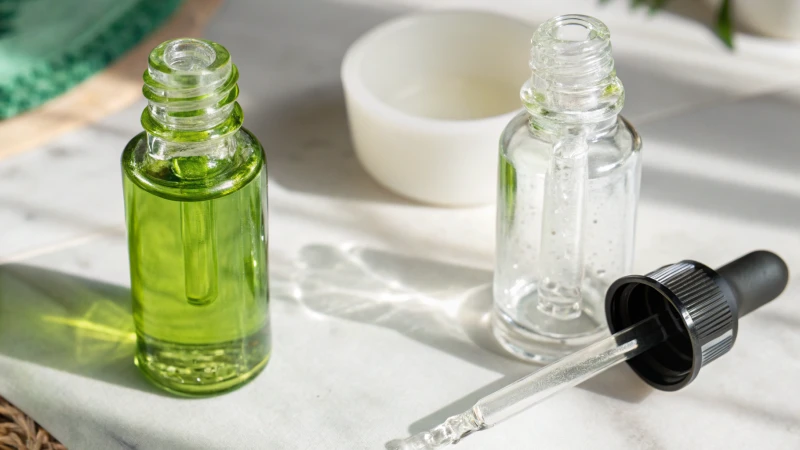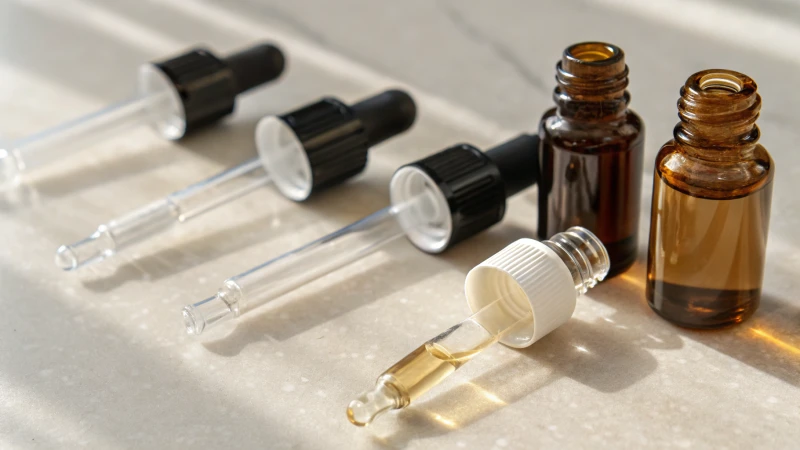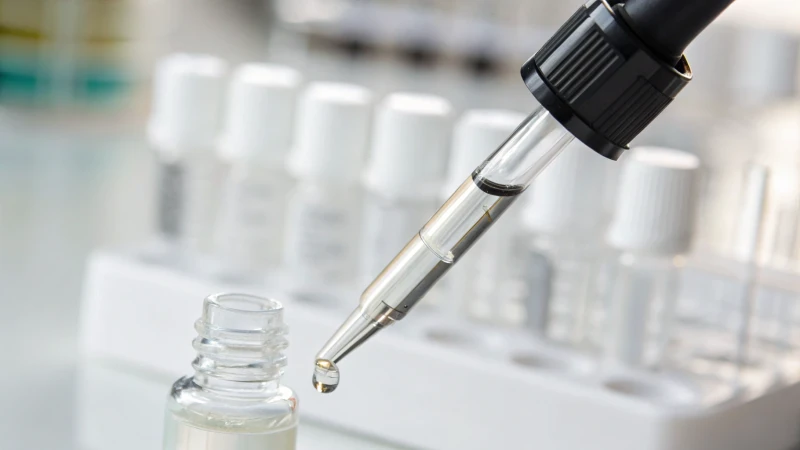
I remember the first time I tried using a glass dropper; it was a complete mess! But don’t worry, it gets easier with a little know-how.
To educate end-users on using glass droppers effectively, emphasize the importance of choosing quality materials, mastering precise handling techniques, and following maintenance tips. This approach ensures accurate dispensing and extends the lifespan of the dropper.
When I first started working with glass droppers, I realized how crucial it was to understand the design variations. For instance, the narrow neck designs require you to get the angle just right for precise measurement, while the wide necks can be tricky with thicker liquids like serums. I also learned that knowing your audience is key—what works for skincare enthusiasts might differ from laboratory technicians. By considering these design and cultural nuances, we can tailor our educational content to make sure everyone feels confident and satisfied with their dropper experience. Sharing these insights not only helps others but also builds trust and enhances our brand’s reputation.
Glass droppers are used only in laboratories.Vals
Glass droppers are used in various industries, including cosmetics.
Proper maintenance prolongs the lifespan of glass droppers.Echt
Regular cleaning and careful handling help extend dropper usability.
What makes glass droppers different from each other?
Ever wondered why some glass droppers feel more reliable than others? Let’s dive into the material differences that make all the difference.
The key material differences in glass droppers lie between borosilicate and soda-lime glass. Borosilicate is known for its high thermal resistance, perfect for sensitive liquids, while soda-lime is more affordable but less sturdy. These variations influence dropper performance and their suitability across different uses.

Borosilicate vs. Soda-Lime Glass
I remember the first time I learned about the differences between borosilicate and soda-lime glass. It was during a hectic week of preparing samples for a major skincare line launch. Borosilicate glass, with its impressive thermal shock resistance, became my go-to for essential oils1 and pharmaceuticals. It reminded me of my kitchen adventures, where a borosilicate measuring cup survived even when I accidentally poured boiling water into it.
| Material | Thermal Shock Resistance | Cost | Ideale toepassingen |
|---|---|---|---|
| Borosilicate | High | $$$ | Pharmaceuticals, Essential Oils |
| Soda-lime | Low | $ | Skincare, General Use |
On the flip side, soda-lime glass is like that trusty old coffee mug—affordable and just right for everyday skincare needs. But let’s face it, it’s not something you’d want to drop on the kitchen floor.
Emerging Trends in Glass Dropper Materials
Lately, I’ve been noticing a shift towards composite glass coatings, such as UV-resistant layers. Imagine saving your favorite serum from UV degradation! This trend isn’t just about protecting the product; it’s about enhancing user satisfaction2—something I deeply value.
Interestingly, preferences vary by region. North American markets often lean towards borosilicate for its alignment with medical standards, whereas Southeast Asian consumers tend to prefer soda-lime due to cost efficiency. It’s fascinating how cultural and regional factors shape material choices.
Impact on User Satisfaction and Brand Perception
Choosing the right material is crucial—not just for performance but for brand perception too. Opting for borosilicate can elevate a brand to premium status, thanks to its durability and reliability. I’ve learned that customers appreciate products that withstand the test of time.
In contrast, brands using soda-lime glass might need to focus on educating users about proper handling to ensure satisfaction. It’s all about striking the right balance between cost and quality.
By understanding these material differences, businesses like mine can make smarter decisions, crafting products that not only meet market demands but also reflect our commitment to quality and design excellence. Ensuring the right material aligns with both the product’s purpose and the target audience is key in this competitive landscape of glass droppers3.
Borosilicate glass has high thermal shock resistance.Echt
Borosilicate glass withstands sudden temperature changes, ideal for sterilization.
Soda-lime glass is more expensive than borosilicate.Vals
Soda-lime glass is cheaper, making it suitable for budget-conscious markets.
How Do Dropper Designs Affect Precision and Usage?
Ever struggled with getting the perfect drop from a dropper? You’re not alone.
Dropper designs affect precision by varying neck designs, bulb capacities, and material quality. A narrow neck ensures better accuracy, while bulb size controls suction. Material choice influences both user experience and precision.

The Influence of Neck Design on Precision
I remember the first time I tried to measure out some essential oil with a dropper. I ended up spilling half of it! That’s when I realized how important the neck design was. Narrow necks are perfect for precise measurements, especially when you’re working with something as delicate as pharmaceuticals. They demand a bit of practice, like getting the suction angle4 just right to avoid errors as tiny as ±0.01 ml. Conversely, wide necks are the go-to for thicker liquids like serums, though I’ve found they can lead to some wastage if not handled carefully.
| Design Type | Ideal Use | Error Margin |
|---|---|---|
| Narrow Neck | Precise measurements | ±0.01 ml |
| Wide Neck | Viscous liquids | Higher |
Bulb Capacity and Suction Control
The bulb capacity was something I never really paid attention to until I faced the frustration of inconsistent suction. The amount a dropper bulb can hold directly impacts how much you can draw up or release at once. If you’re anything like me, trying out different designs to find that sweet spot can be crucial, especially if you’ve ever been stuck with a dropper that either doesn’t pick up enough or floods your mixture.
Material Quality and Its Effects on Usage
The material of a dropper also plays a big role in its usability. I learned this the hard way after one of my soda-lime glass droppers shattered unexpectedly. Now, I lean towards borosilicate glass5, which offers great thermal resistance and is perfect for handling sensitive liquids like essential oils. While soda-lime glass is more budget-friendly, it’s also more fragile, which can be a dealbreaker depending on your use case.
| Type materiaal | Key Features |
|---|---|
| Borosilicate Glass | High thermal shock resistance, ideal for sensitive liquids |
| Soda-lime Glass | Cost-effective, suitable for everyday use |
Emerging Trends in Dropper Design
Exciting new trends are emerging in the world of droppers! I’ve recently come across smart droppers with automatic dosing features that make life so much easier by reducing wastage and ensuring precision. These innovations are making waves in high-end markets, especially for those of us who crave both accuracy and a touch of luxury.
Explore more about smart droppers6 and how they are reshaping user expectations in the cosmetic industry.
Narrow neck droppers have an error margin of ±0.01 ml.Echt
Narrow necks are designed for precise measurement, minimizing error to ±0.01 ml.
Borosilicate glass is more fragile than soda-lime glass.Vals
Borosilicate glass is more durable and resistant to thermal shock than soda-lime glass.
How Can You Make Your Droppers Last Longer?
Ever wondered why some droppers last longer than others? I’ve discovered a few simple tricks that have worked wonders for me, and I’m excited to share them with you!
To extend the life of your droppers, make it a habit to clean them with distilled water, steer clear of harsh chemicals, and store them upright. Every now and then, lubricate the moving parts to keep them functioning smoothly.

Cleaning Routine for Droppers
It’s amazing how much a little cleaning can do! After each use, I make sure to rinse my droppers thoroughly with distilled water. This simple step prevents residue buildup, which can lead to annoying blockages or even deterioration over time.
-
Materials Needed:
Item Purpose Distilled Water Prevents mineral deposit buildup
I’ve learned the hard way that strong cleaning agents7 can actually degrade the materials, so it’s best to avoid those.
Proper Storage Practices
Storing your droppers correctly is just as important as cleaning them. I always ensure mine are kept in a vertical position. This prevents any liquid from seeping into the bulb or mechanism, which could cause issues later on.
- Storage Environment:
- Cool and dry places are ideal.
- Avoid direct sunlight exposure to prevent material degradation.
Lubrication of Moving Parts
For those droppers with mechanical components, like the ones in automatic dosing systems, periodic lubrication is key. I use a silicone-based lubricant that is compatible with the materials of my dropper.
- Lubrication Steps:
- Apply a small amount of lubricant to the moving parts.
- Operate the dropper to distribute evenly.
I always check the manufacturer’s guidelines for specific recommendations on how often I should be doing this.
Monitoring for Wear and Tear
Regular inspections have saved me more times than I can count. Checking for any signs of wear, like cracks or reduced suction capability, helps catch problems early and keeps everything running smoothly. If I notice any wear, I consider replacing parts to maintain optimal performance.
User Education and Habits
I’ve found that understanding the right way to use my droppers makes a huge difference in their lifespan. I try to familiarize myself with the correct usage angles and pressure application to prevent damage. Providing clear instructions—whether in packaging or online resources—can really enhance understanding and care.
Summary Table of Maintenance Tips:
| Maintenance Aspect | Key Action |
|---|---|
| Cleaning | Use distilled water post-use |
| Storage | Keep upright in a cool, dry environment |
| Lubrication | Apply silicone lubricant periodically |
| Wear and Tear Monitoring | Inspect regularly for damage |
| User Education | Provide clear usage instructions |
By incorporating these maintenance tips into my routine, I’ve enjoyed extended lifespans and consistent performance from my droppers. For additional resources on dropper care8, I’ve explored expert guides available online.
Distilled water prevents mineral buildup in droppers.Echt
Distilled water lacks minerals, preventing deposits that cause blockages.
Direct sunlight exposure is ideal for dropper storage.Vals
Sunlight can degrade materials, shortening the dropper's lifespan.
How Does User Education Differ Across Cultures?
Have you ever wondered why education feels so different when you cross borders? Let me share some insights from my own experiences that might just surprise you.
User education varies across cultures due to differing cultural values, teaching methods, and communication styles. These differences shape educational approaches, influencing both content delivery and student engagement.

Educational Values and Priorities
In my journey through various cultures, I’ve noticed how differently education is valued. In some Western cultures, there’s a big push for critical thinking9, urging students to challenge the norm and think independently. I remember sitting in a classroom where debates were encouraged, each student voicing their opinion confidently. On the flip side, my time in East Asia taught me about the reverence for academic excellence through rote learning. Here, discipline and academic rigor10 take center stage, and I found myself marveling at the sheer dedication of students mastering complex material through repetition.
| Culture | Priority | Methodology |
|---|---|---|
| Western | Critical thinking | Interactive |
| East Asian | Academic rigor | Rote learning |
Teaching Methods and Styles
Teaching styles can be as varied as the cultures themselves. Back in the United States, classrooms buzz with a participatory approach. I loved the energy in the room as students eagerly participated in discussions. Meanwhile, my experiences in Japan introduced me to a more traditional, lecture-based style where knowledge flows directly from teacher to student—each method has its own charm.
- Participatory Approach: Encourages open dialogue and fosters creativity.
- Lecture-Based Style: Focuses on comprehensive coverage of subjects through structured teaching.
Communication Styles in Education
Communication, too, dances to the tune of cultural norms. In some places, direct communication is key. I recall being urged to speak up and assert my opinions without hesitation. In contrast, other cultures prefer indirect communication, where reading between the lines is an art form. Here, students learn to grasp the essence of a lesson from subtle cues rather than overt statements.
- Direct Communication: Seen in cultures that value transparency11 and assertiveness.
- Indirect Communication: Common in cultures where harmony and subtlety are prioritized.
Exploring these variations has given me invaluable insights into crafting educational strategies that respect cultural nuances while boosting global learning outcomes. This understanding is not just crucial for educators; businesses too can benefit by developing culturally sensitive educational materials for international markets. It’s all about embracing these differences to foster a truly enriching learning experience.
Western education values critical thinking over rote learning.Echt
Western cultures emphasize independent exploration, unlike rote learning.
Japanese classrooms primarily use a participatory approach.Vals
Japanese education typically employs a lecture-based style.
Conclusie
Educating end-users on glass droppers involves emphasizing material quality, handling techniques, and maintenance tips to ensure accurate dispensing and enhance user satisfaction across various applications.
-
Learn about borosilicate’s benefits for essential oils, ensuring safety and efficacy. ↩
-
Discover how UV-resistant coatings enhance product longevity and user experience. ↩
-
Explore various glass dropper types suited for specific uses. ↩
-
Exploring this link will provide insights into achieving the best suction angle for narrow neck droppers, enhancing precision. ↩
-
Discover why borosilicate glass is preferred for packaging essential oils, focusing on its thermal shock resistance and suitability. ↩
-
Learn how smart droppers are revolutionizing cosmetics with precise dosing features, improving user experience and reducing waste. ↩
-
Discover why strong cleaning agents may harm glass droppers and learn alternative methods for safe cleaning. ↩
-
Explore comprehensive guides on dropper maintenance to ensure long-lasting performance and reliability. ↩
-
Learn why critical thinking is a cornerstone of Western education systems and its impact on student development. ↩
-
Discover the significance of rote learning in East Asian education systems and its cultural roots. ↩
-
Understand the differences between direct and indirect communication styles in educational contexts. ↩



